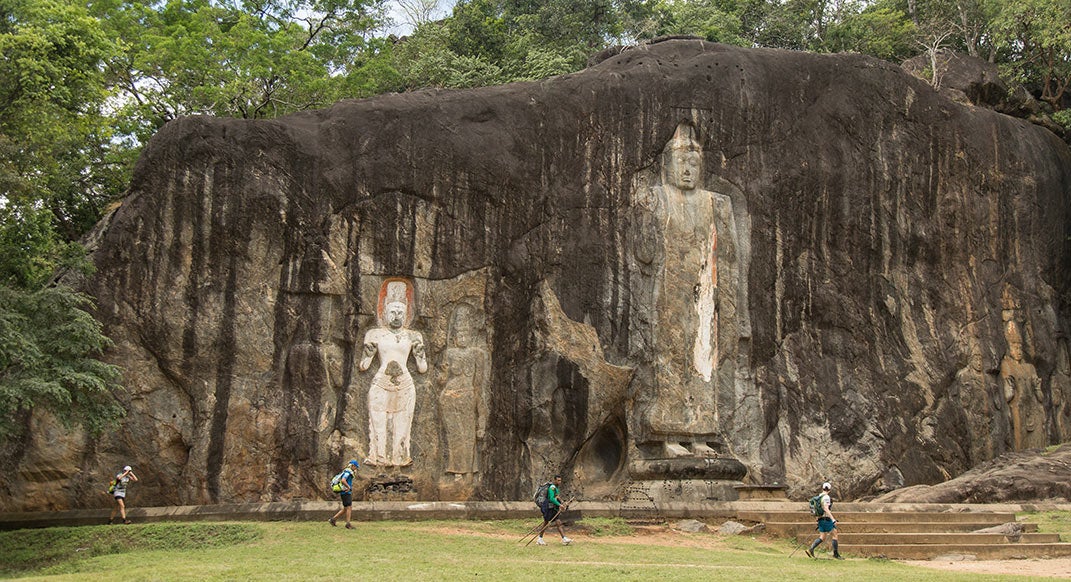Photo Gallery: An Adventurous Stage Race in Sri Lanka

The 2016 edition of the 250-kilometer 4 Deserts Roving Stage Race took place between February 14 and 20 on the small island nation of Sri Lanka. It was the 48th race from 4 Deserts, known for putting on foot races in some of the world’s most remote and culturally rich environments. The event attracted 78 runners ages 18 to 71 from over 20 countries who hoped to push their limits in a self-supported expedition across the country, which until 2009 had been engaged in a 25-year civil war.
The course was a beautiful showcase of the wide range of terrain and cultures found in Sri Lanka. Starting with steep stages in the mountainous Central Province near Nuwara Eliya, the race reached over 7,000 feet before descending through jungles, tea plantations, rice fields, temples and water crossings to finish at the Indian Ocean, in Yala National Park on the southern coast.
Without an established trail system or even road maps for many of the areas, the course utilized one-lane dirt roads or local footpaths that connected remote villages throughout the countryside. Stages were marked the day before by volunteers and double-checked each morning, as many village children would take the bright-pink course markings to use as hair ribbons.
The strange sight of racers always drew the curiosity of the locals, who had never seen a race before and would line the course or congregate at checkpoint stations to cheer on racers, sometimes helping volunteers with timing by calling out bib numbers. The race was initially planned as a six-stage race with a long 80-kilometer stage, but the long stage was divided in two at the last minute, due to the dangers of running in elephant and sloth-bear territory at night.
The logistics of putting together a race through a developing country like Sri Lanka required intense planning by organizers, the support of several levels of government and over 70 staff and volunteers. The Sri Lankan military provided around 30 soldiers for logistical support and protection. Despite the recent civil war, which took place on the northern end of the island, Sri Lanka is considered safe for travelers and the military’s presence was largely for protection from dangerous animals common along the course, such as elephants, sloth bears, snakes and alligators.
To foster soldier engagement and friendly competition among the army, navy and air-force members protecting the racers, seven entries were given to military personnel. All of them finished, despite no experience with stage racing and running with heavy military-issue gear and local resources like sugar-cane trekking poles
Elephants were a big concern throughout the course, but especially toward the finish as racers passed through Yala National Park, a popular safari location on the southern coast. The race was granted permission to cross the park on foot—a first—on the condition that the last 10 kilometers of the 50K Stage 6 (where elephants were the most prevalent) not count toward finishing times, so racers could band together in groups of six to eight and move with military-staffed jeeps for safety.
Other than the occasional coconut, sugar cane or banana found along the course, racers were responsible for carrying their own gear and food while navigating an average of 40 kilometers a day through the remote countryside. Mandatory gear checks conducted before the race ensured racers had their required equipment and at least 2,000 calories a day worth of food.
Racers utilized lightweight gear and calorie-dense foods to get their pack weights as light as possible (most between 15 and 25 pounds). Water for hydrating and for dehydrated meals was provided at camps and stage checkpoints (over 10,000 liters were used during the week), and shelters were set up each night either in a local building (like on the floor of an old tea factory) or in assigned eight-person tents set up alongside elephant watering holes, next to Buddhist temples or on the beach.
The challenge of racing an off-road marathon a week would be tough enough for most people, but these racers had to deal with running and recovering from that distance every day for seven days while weighed down by their supplies. Racers fell into a daily grind of early wakeups, sometimes in rain-swamped tents, to prepare their gear for a full day of racing. As the elevation dropped, they dealt with rising tropical heat and humidity and struggled to keep their gear dry during river crossings and the intermittent rainstorms that began mid-week. Upon arriving back at camp, they would quickly find shade or start drying their clothes and begin the communal process of resting, preparing dehydrated dinners, sharing stories and making adjustments for the next day.
Injuries were common—the dropout rate was 22 percent—and proper foot and blister treatment became a pivotal nightly routine. A five-person medical team from the United States was posted at stage checkpoints to treat racers along the course, and would work late into the night, treating injuries, illnesses, heat exhaustion and mangled feet.
Two Australians persevered through the brutal course to cross the finish line on the Indian Ocean first, with 30-year-old Joseph McCann finishing in 28:17:37 and 56-year-old Sandy Suckling finishing in 31:40:27. Rounding out the podium for the men were Ralph Crawley of the United States and Rafael Fuchsgruber of Germany; continuing the pattern for the women were Jax Mariash Koudele, also of the United States, and Magdalena Dombek, also of Germany.
The Sri Lanka race was indeed a once-in-a-lifetime opportunity. Each 4 Deserts Roving Race is held only once before it moves on to a new culturally rich location—Patagonia, in 2017.
This article originally appeared in our July 2016 issue.